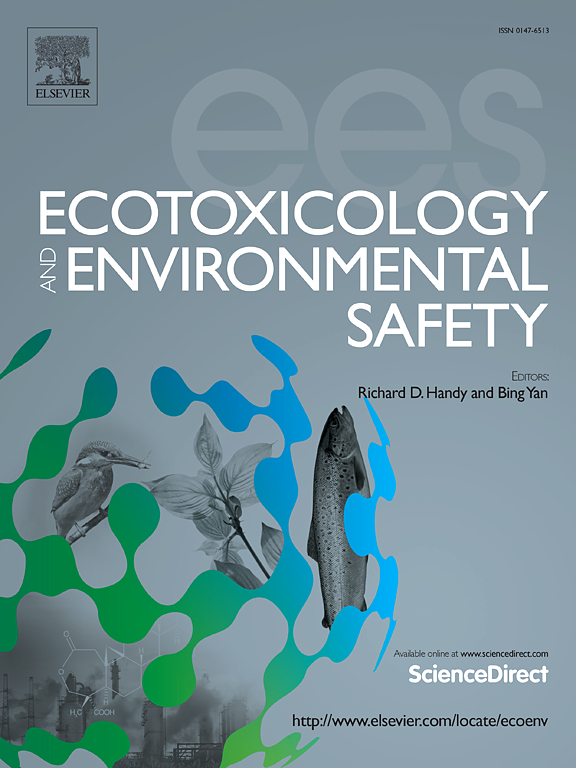Impact of iron exposure on Brazilian coral reefs: Acute vs. chronic stress responses
IF 6.2
2区 环境科学与生态学
Q1 ENVIRONMENTAL SCIENCES
引用次数: 0
Abstract
Prior research has shown that exposure to metals increases corals vulnerability to bleaching by heightened oxidative stress. Understanding the impact of metal contamination on coral health in their natural environmental is crucial. This study investigate the effects of iron (Fe) exposure on Brazilian coral reef species. We evaluated the response of Mussismilia harttii, Millepora alcicornis, and Siderastrea sp. to acute (4 days) and chronic (28 days) Fe exposure under environmentally relevant concentrations (0, 100, 300 and 900 μg L−1). Experiments were conducted in laboratory and in a marine mesocosm Biomarkers including Fe bioaccumulation, lipid peroxidation (LPO), protein carbonylation (PCN), and DNA damage were measured. The correlation between chronic exposure results and environmental factors were also analyzed. The hypotheses were: a) Fe exposure would increase ROS production in corals, leading to biomolecule damage; b) acute and chronic Fe exposure would affect ROS production and biomolecule damage differently; c) Fe bioaccumulation would vary between species and concentrations; and d) environmental factors might influence coral responses to Fe. Results indicated that all species exhibited increased Fe bioaccumulation as metal concentrations increased, suggesting a common ability to absorb and accumulate Fe. The oxidative damage response vired between acute and chronic exposure, with acute exposure causing more damage while chronic exposure showed a temporal reduction in damage. Environmental factors (e.g. temperature, pH, salinity and dissolved oxygen) also influenced the coral responses, either exacerbating or mitigating oxidative stress effects. These findings highlight the importance of understanding Fe contamination impacts for the conservation of Brazilian coral reefs.
铁暴露对巴西珊瑚礁的影响:急性与慢性应激反应
先前的研究表明,接触金属会增加珊瑚因氧化应激加剧而容易白化。了解金属污染对自然环境中珊瑚健康的影响至关重要。本研究探讨了铁(Fe)暴露对巴西珊瑚礁物种的影响。我们评估了在环境相关浓度(0、100、300和900 μg L−1)下,harttii Mussismilia alcicornis, Millepora alcicornis和Siderastrea sp.对急性(4天)和慢性(28天)铁暴露的反应。实验在实验室和海洋环境中进行,测量了生物标志物,包括铁的生物积累、脂质过氧化(LPO)、蛋白质羰基化(PCN)和DNA损伤。分析了慢性暴露结果与环境因素的相关性。假设是:a)铁暴露会增加珊瑚体内活性氧的产生,导致生物分子损伤;b)急性和慢性铁暴露对ROS生成和生物分子损伤的影响不同;c)不同种类和浓度的铁的生物累积量不同;d)环境因素可能影响珊瑚对铁的反应。结果表明,随着金属浓度的增加,所有物种的铁生物积累量都增加,表明它们具有吸收和积累铁的共同能力。氧化损伤反应在急性暴露和慢性暴露之间传播,急性暴露造成更多的损伤,而慢性暴露显示出暂时的损伤减少。环境因素(如温度、pH值、盐度和溶解氧)也会影响珊瑚的反应,加剧或减轻氧化应激的影响。这些发现强调了了解铁污染对巴西珊瑚礁保护的重要性。
本文章由计算机程序翻译,如有差异,请以英文原文为准。
求助全文
约1分钟内获得全文
求助全文
来源期刊
CiteScore
12.10
自引率
5.90%
发文量
1234
审稿时长
88 days
期刊介绍:
Ecotoxicology and Environmental Safety is a multi-disciplinary journal that focuses on understanding the exposure and effects of environmental contamination on organisms including human health. The scope of the journal covers three main themes. The topics within these themes, indicated below, include (but are not limited to) the following: Ecotoxicology、Environmental Chemistry、Environmental Safety etc.

 求助内容:
求助内容: 应助结果提醒方式:
应助结果提醒方式:


